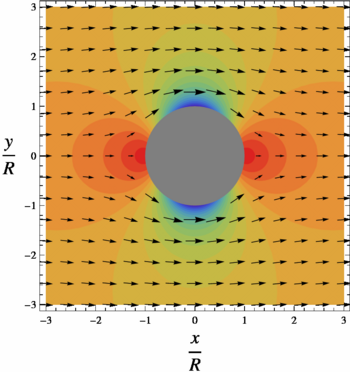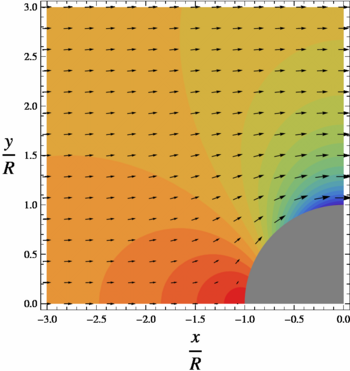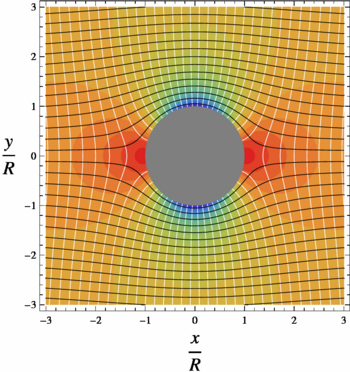Fluid flow past a cylinder: Difference between revisions
imported>Brian Fiedler |
imported>Brian Fiedler No edit summary |
||
| Line 16: | Line 16: | ||
Being incompressible, <math>\nabla\cdot\vec{V}=0</math>, so <math>\phi</math> must satisify Laplace's equation: | Being incompressible, <math>\nabla\cdot\vec{V}=0</math>, so <math>\phi</math> must satisify Laplace's equation: | ||
:<math> \nabla^2\phi=0</math> | :<math> \nabla^2\phi=0</math> | ||
The solution for <math>\phi</math> is obtained most easily in polar coordinates <matth>r</math> and <math>\theta</math>, related to conventional Cartesian coordinates by <math>x=r\cos\theta</math> and <math>y=r\sin\theta</math>. In polar coordinates, Laplace's equation is: | |||
:<math>\frac{\partial^2\phi}{\partial r^2} + \frac{1}{r}\frac{\partial \phi}{\partial r} + \frac{1}{r^2} \frac{\partial^2\phi}{\partial \theta^2}=0</math> | |||
The solution that satisfies the boundary conditions is | |||
:<math>\phi(r,\theta)=U\left(r+\frac{R^2}{r}\right)\cos\theta</math> | |||
The velocity components in polar coordinates are obtained from the components of <math>\nabla\phi</math> in polar coordinates: | |||
:<math>V_r=\frac{\partial \phi}{\partial r} = U\left(1-\frac{R^2}{r^2}\right)\cos\theta</math> | |||
and | |||
:<math>V_\theta=\frac{1}{r}\frac{\partial \phi}{\partial \theta} = - U\left(1+\frac{R^2}{r^2}\right)\sin\theta</math> | |||
Being invisicid and irrotational, Bernoulli's equation allows the solution for pressure field to be obtained directly form the velocity field: | |||
:<math> p=\frac{1}{2}\rho\left(U^2-V^2\right) + p_\infty</math> | |||
where the constants <math>U</math> and <math>p_\infty</math> appear to that <math>p\rightarrow p_\infty </math> far from the cylinder, where <math>V=U</math>. | |||
Revision as of 21:06, 29 May 2009
"The flow of an incompressible fluid past a cylinder is one of the first mathematical models that a student of fluid dynamics encounters. This flow is an excellent vehicle for the study of concepts that will be encountered numerous times in mathematical physics, such as vector fields, coordinate transformations, and most important, the physical interpretation of mathematical results." [1]
Mathematical Solution
A cylinder (or disk) of radius is placed in two-dimensional, incompressible, inviscid flow. The goal is to find the steady velocity vector and pressure in a plane, subject to the condition that far from the cylinder the velocity vector is
and at the boundary of the cylinder
where is vector normal to the cylinder surface. The upstream flow is uniform and has no vorticity. The flow is inviscid, incompressible and has constant mass density . The flow therefore remains without vorticity, or is said to be irrotational, with everywhere. Being irrotational, there must exist a velocity potential :
Being incompressible, , so must satisify Laplace's equation:
The solution for is obtained most easily in polar coordinates <matth>r</math> and , related to conventional Cartesian coordinates by and . In polar coordinates, Laplace's equation is:
The solution that satisfies the boundary conditions is
The velocity components in polar coordinates are obtained from the components of in polar coordinates:
and
Being invisicid and irrotational, Bernoulli's equation allows the solution for pressure field to be obtained directly form the velocity field:
where the constants and appear to that far from the cylinder, where .



























